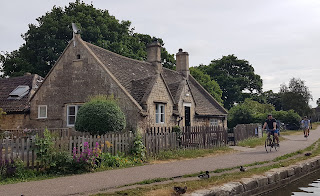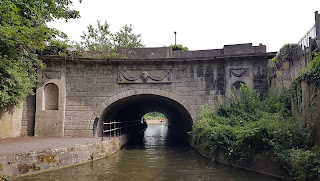Today's Navigations - Kennet and Avon Canal, River Avon
We began the day by reversing back under the road bridge to a water point where we filled up before setting off properly.
This small cottage appears now to be part of the pub but possibly dates back centuries.
Following on, this terrace of cottages, in on all the OS maps as far back as we can access and is labelled simply Canal Terrace. Possibly it housed workers for the stone wharf.
On the opposite side is the modern retirement complex that replaced Harbutt's Plasticine Factory.
The first half of the route into the city centre is still quite green, with plenty of vegetation alongside the water's edge.
We had hoped to find a sani station but alas there is none in the city, except for private, paid-for ones. So that service will have to wait!
Eventually we arrived into the main part of Bath, passing through two short tunnels, one with a substantial house on top. The first is called Beckford Tunnel or, according to the CaRT modern blue sign, more prosaically, Bath Tunnel No 1!
Followed by Cleveland House Tunnel. Built in 1817, the house was originally called Canal House, but renamed in honour of the Duke of Cleveland whose estate leased it to the canal company and housed its Board Room.
The Bath Locks are in two sets of three. The top half are quite similar and have similar construction.
Alas the refreshment stop was closed today - not to be confused with the much posher Pump Room!
No need for the internet to check the time here!
The photo is timestamped at 10:49. Dial seems to be set to summer time.
The second set incudes the famous Bath Deep lock, the second deepest on the network, only exceeded by Tuel Lock. In both cases, they replace two former locks which had been built over by road widening in a period when the navigation was closed. The lock here is self operated - the bottom gates are particularly hard work. The road widening did not leave enough room for proper balance beams and so the gates are opened and close by a geared mechanism worked by a windlass. It takes around 110 turns to open and then the same to shut again. (Sorry, missed a photo with all the effort!)
The final lock drops down onto the river. Apart from only having one top paddle operations so that filling is very slow, it is otherwise quite conventional. However, there is no room for an immediate lock landing and boats have to exit onto the river to find a pontoon just below, after a very sharp left hand bend. In between the bridge and the pontoon is a fast flowing stream entering the main river which makes steering onto the pontoon a bit tricky. Christine managed successfully to come to the pontoon to allow Mike to leap aboard. The problem then was how to escape from the pontoon with a strong stream pushing the boat into the edge. We managed but not before almost wedging the front of the cabin under a protruding overhang! We only lost a bit of paint, nothing more serious.
We were aiming for the riverside moorings just below several of the bridges across the river in the city centre. The area either side of the river at this point forms a major redevelopment project for the local council. The railings and bank wall have all been upgraded - although there are quite a few mooring rings, it is clear that boats are expected to moor to the railings along some stretches. We explored until the end of the moorings and then turned to come back upstream (always the best thing to do on a river) to a spot we selected as we passed by.
Newark Works is all that remains of the engineering company Stothert and Pitt, once a major employer in the area. Now converted to provide small offices and work spaces.
This photo can be compared with one we took nine years ago, before its conversion.
It was now lunch time. Later, Christine walked down to the large Sainsbury store ( we needed a few food items but the main aim was to exchange a pair of shorts she bought in Bradford on Avon which turned out not to be the size she thought they were)
Meanwhile, Mike sorted details for the arrival into the Floating Harbour at Bristol. The lock keeper at Netham told us that paying for entry can now be done via an app so that boats no longer need to moor and queue up to see the keeper when they arrive. Of course, that meant deciding how long we want to stay so a rough timetable for the period up to our next set of appointments from home had to drafted. We have now booked and paid for three days, in practice that will mean two full days.
2.8 Miles - 6 Locks


















No comments:
Post a Comment